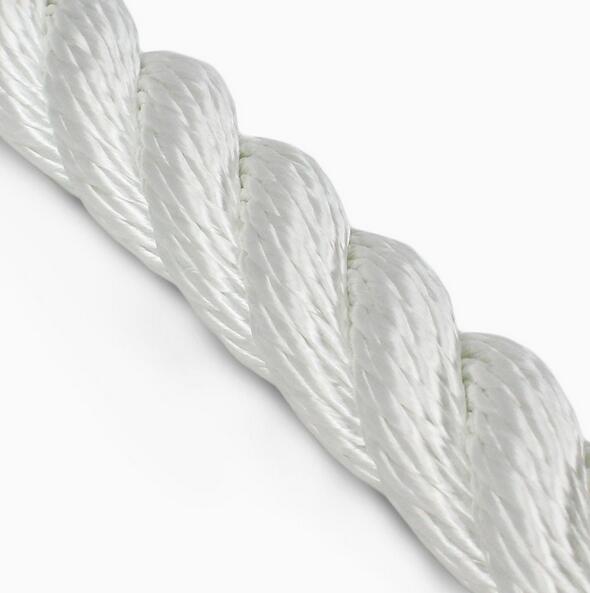Does Nylon Rope Stretch? 5 Thinks You Need to Konw
What Is Nylon Rope?
Nylon rope, a very strong rope, and multipurpose material, is applied across various industries thanks to its synthetic materials and fabric structures. The most common question that comes to mind for users is whether nylon ropes stretch. The response, as usually the case is not a simple yes or no but a mixture of both. Numerous factors of this material extension are subject to consideration, such as its construction, thickness, and the weight it carries. In this blog post, we will address the key factors that cause nylon rope to stretch apart, and also discuss its applications where stretch may be a good or bad quality.

Understanding Nylon Rope Stretch
Nylon is a synthetically manufactured fiber, known for its impressive stretch resistance, stretching approximately 15-28% at break. This consequently implies that the synthetic rope can be stretched up to almost twice before they will break down in comparison to polyester ropes. Nylon’s flexibility is due to its molecular structure that permits the chains of the polymer molecules to form a unison as they align and get stretched under tension.
The stretch factor of ropes plays a vital role in dynamic applications, for instance, climbing, canyoning, and rescue operations. As shock loading occurs, the rope can resist tears and jerks making it safe for both the rope and the user. This feature of nylon ropes, along with their abrasion resistance, makes them a perfect choice for activities where the ability to stretch and absorb shock is crucial for performance and safety.
Nylon Vs Polyester Rope Stretch
When examining the differences nylon and polyester ropes exhibit, the main distinctions are found in their stretch capacities, water absorption rates, and temperature resistance properties. Nylon exhibits a 15-28% elongation at break, thus, it has a higher ability to absorb shock, which is essential for dynamic applications like climbing and towing. Yet, highlighting one of nylon’s potential weaknesses, unlike nylon, polyester retains its strength when wet and offers superior heat resistance.
The elongation of polyester, which is roughly 10%, however, is slightly less than that of nylon. It can still maintain its strength when wet and stands at higher temperatures. It enjoys popularity in marine applications and those requiring dimensional stability. Both materials are synthetic and wear-resistant, but their unique properties make them suitable ropes for different applications.
Molecular Structure Impact on Stretch
The molecular structure of nylon is as important as its stretching properties. Nylon has amide linkages (-CO-NH-) in the chains of its polymer that result in more flexibility compared to polyester, which has ester linkages (-CO-O-). This flexibility allows the nylon polymer chains to line up and stretch more easily when tension is applied. As a result, the elongation rate recorded until a break occurs can range from 15-28%.

Contrary to this, polyester’s ester bonds give it higher stiffness and ability to resist stretching causing the stretch factor at the break to be approximately 12-15%. The difference in molecular structures enhances nylon’s flexibility compared to polyester, making nylon a better choice for applications that require superior shock absorption and flexibility.
Stretching Of Nylon Rope:Factors To Consider
Several factors can influence the stretch characteristics of nylon ropes:
Rope construction:Ropes can be stretched differently depending on how they are braided or twisted. The stretch of closely spaced strings is less than that of wider strings.
Rope diameter:The diameter of the rope significantly affects its stretching properties. Nylon ropes come in sizes that can be used for many purposes:1/4 inch, 1/2 inch, 3/8 inch, 3/4 inch, 5/8 inch, and 1-inch diameters. Thicker ropes, such as the 1-inch nylon rope, are therefore more likely to have higher stretch than thinner ones due to the larger diameter of the rope, causing it to experience more resistance toward stretching.
Load applied: The strength or mass with which the string was subjected determined how the string was likely to extend. Lifted loads exert greater stretch on the rope compared to the case of lighter ones.
Environmental conditions:The extent of the stretch in the case of nylon ropes can be affected by temperature and moisture. The nylon rope could be made longer or lose some of its elasticity when exposed to wet environments or extremely high temperatures over time.
Applications of Nylon Rope Stretch

Elastic Properties
Climbing and mountaineering:
Another reason that makes this material be shock-absorbing is the quality of elasticity present on the nylon ropes, hence reducing the tension caused by a fall on the climber and their climbing gear.
Towing and recovery:
Nylon ropes are generally implemented in towing operations, like pulling vehicles out from the mud or snow, by their characteristic of stretching and absorbing the shock of sudden loads.
Lifting and rigging:
However, they are not the best choice in such situations where dimension stability is a requirement. They, though, can have an advantage in certain lifting operations where shock absorption is needed.
Mooring and anchoring:
One of the reasons for the less frequent use of nylon ropes instead of polyester ropes during mooring and anchoring relates to their performance in wet environments, where their strong capability for water absorption can lead to significant strength loss. On the other hand, their stretchability can continue to absorb the shock of the waves and wind.
Visual and Safety Considerations:
More colors such as black nylon rope, yellow nylon rope, red nylon rope, blue nylon rope give you the choice to really combine functionality with looking excellent, whether it’s for professional trade use or the weekend DIY project. This makes the colored rope especially ideal in applications that require high visibility, for example, safety lines or where the ropes need to be easily identifiable.
Nylon Rope Care and Storage
Due to its synthetic composition, nylon rope not only requires specific care and storage to maintain its strength and longevity but also consistently outperform natural fiber ropes in durability and resistance to environmental factors.
● Keep ropes clean and dry to prevent deterioration.
● Avoid exposure to sunlight and harsh chemicals.
● Store ropes in a cool, dry place away from direct sunlight.
● Coil ropes properly to prevent kinks and tangles.
● Inspect ropes regularly for signs of wear and damage.
One of the most important features that make nylon rope stretchy is the fact that it gives this versatility and usefulness because of the synthetic material. Nylon ropes are a great pick for dynamic applications since they can stretch and absorb shock loads, which makes them a perfect choice for safety purposes where flexibility is indispensable. Through knowledge of the factors that affect nylon rope stretch and where it is mostly applicable, users can make informed choices and select the exact rope. Transform your project with Thispower choosing the Nylon rope exactly what you need.is appropriate for their needs.
